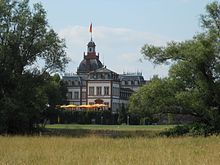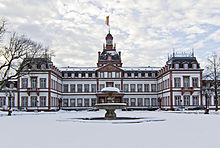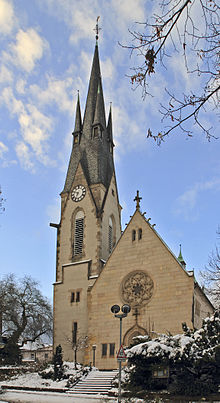Hanau-Kesselstadt
|
Kesselstadt
City of Hanau
|
|
|---|---|
| Coordinates: 50 ° 8 ′ 0 ″ N , 8 ° 53 ′ 0 ″ E | |
| Height : | 104 m above sea level NHN |
| Area : | 3.26 km² |
| Residents : | 11,668 (Jun 30, 2020) |
| Population density : | 3,579 inhabitants / km² |
| Incorporation : | April 1, 1907 |
| Postal code : | 63454 |
| Area code : | 06181 |
Kesselstadt has been a district of Hanau in the Main-Kinzig district in Hesse since 1907 and was previously an independent municipality.
geography
location
Kesselstadt borders in the north on the Hanau districts northwest, in the east on the city center, in the southeast on the district southeast, in the south, on the opposite side of the Main, on Steinheim . Kesselstadt also borders the Dietesheim district of Mühlheim am Main in the southwest and the Dörnigheim district of the city of Maintal in the west .
Kesselstadt lies at 102 m above sea level .
Settlement geography
The district is characterized by the Main in the south, the Philippsruhe Palace with its park, from which several avenues ( Philippsruher Allee , Kastanienallee and Burgallee ) radiate away and the old town center around the Friedens- and Reinhardskirche . To the west adjoins a new housing estate from the 1960s and 1970s - the Weststadt - and, separated by a forest area, the east industrial area of the city of Maintal . Little is known about the fact that the residential areas around Frankfurter Landstrasse and Gustav-Hoch-Strasse with Beethovenplatz and Rosenau once belonged to the Kesselstadt district. In the north are the former Wilhelmsbad basalt quarries (today partly a nature reserve ), the pheasantry , which is now used as a golf course , and the parks and buildings of the historic Wilhelmsbad spa complex .
history
Prehistory and early history
In the district of Kesselstadt, graves and remains of settlements from almost every period since the Neolithic Age have been excavated. On the north bank of the Main there was a Celtic settlement in the area of the old town center . The name Kesselstadt, "Castell-Stätte", goes back to a large Roman stone fort from Roman times , which later occupied part of the medieval town center . Another important Roman settlement was on the "Salisberg" (Salisweg), where in the late first century AD the Salisberg fort was initially built to protect the Main crossing and later a large civilian settlement developed, which a few decades before the Limesfall went down in the third century AD. In one of the fountains of the settlement, among others, the oldest datable written certificate of Germany was found: a small wooden writing board on the on April 5th of the year 130 in Mainz a receipt was issued AD... Further evidence of this settlement are the foundations of a Roman bath in the Kesselstädter Friedhof (in Baumweg) .
Administrative district
- Village of the office of Bücherthal
- 1787: Landgraviate of Hesse, County of Hanau-Munzenberg, Office of Bücherthal
- 1803: Electorate of Hesse, Principality of Hanau, Amt Bücherthal
- 1806 / 7-10: French Empire, Principality of Hanau, Amt Bücherthal (military administration)
- 1810–1813: Grand Duchy of Frankfurt, Hanau Department, Bücherthal District
- 1816: Electorate of Hesse, Principality of Hanau, Office of Bücherthal
- 1821: Electorate of Hesse, Province of Hanau, District of Hanau
- 1848: Electorate of Hesse, Hanau district
- 1851: Electorate of Hesse, Province of Hanau, District of Hanau
- 1867: Kingdom of Prussia, Hesse-Nassau Province, Kassel District, Hanau District
- 1907: Kingdom of Prussia, Hesse-Nassau Province, Kassel District, Hanau District
middle Ages
Early settlement finds in the medieval Kesselstadt were found a few years ago during excavations by the Hanau History Association at the Friedenskirche and date back to the 8th and early 9th centuries. In the Middle Ages , Kesselstadt was a traders, craftsmen and fishing village on the Main. In 1247 the lords of Eppstein and the lords of Hanau were joint court lords in Kesselstadt. Only in 1339 can the Lords of Hanau prove sole ownership of the court. The village belonged to the allodial property of the Lords of Hanau , to the rule and later county of Hanau , from 1458: County of Hanau-Munzenberg , and here to the office of Büchertal . Ecclesiastically the village belonged to the Archdiocese of Mainz . The middle church authority was the Archdiaconate of the Provost of the Church of St. Maria ad Gradus in Mainz , Landkapitel Roßdorf . The village chapel was originally dedicated to St. Mary and St. Catherine . In 1353 a pastor and a chaplain were named for the first time. The patronage was up to the Reformation in 1561 the monastery Naumburg or its parent monastery Limburg .
The later imperial counts of Kesselstatt originally came from the village, but in the 14th century they initially moved their focus to Montabaur and later entered the electoral service in Trier .
Historical forms of names
Kesselstadt was mentioned under the following names in documents that have survived (the year in which it was mentioned in brackets):
- Chezsilstat (1059)
- Keszelstat (1237)
- Boiler Stat (1247)
Early modern age
In the middle of the 16th century, the Reformation took hold in the county of Hanau-Münzenberg, initially in its Lutheran form. In a "second Reformation", the denomination of the County of Hanau-Munzenberg was changed again: From 1597 Count Philipp Ludwig II pursued a decidedly reformed church policy. He made use of Jus reformandi , his right as sovereign to determine the denomination of his subjects, and made this largely binding for the county, as was the case in Kesselstadt. At the turn of the 16th to the 17th century he also built a summer residence on the edge of the village, which, like the village, suffered severe damage in the Thirty Years' War . In the early 18th century, the last two Hanau counts built Philippsruhe Castle here. After the death of the last Hanau count, Johann Reinhard III. , 1736, Landgrave Friedrich I of Hessen-Kassel inherited the County of Hanau-Münzenberg and with it the office of Büchertal and with this Kesselstadt due to an inheritance contract from 1643.
At the beginning of the 18th century a Lutheran congregation developed again in Kesselstadt, which eventually also built its own church, today's Reinhardskirche . With the Hanau Union of 1818, this double denominational structure became superfluous. The church has now been abandoned for worship and used as a school building and other purposes. Today the building serves as a communal event space and can be rented for private celebrations.
Modern times
During the Napoleonic period, Kesselstadt - like the rest of the Büchertal office - was under French military administration from 1806 to 1810 and then from 1810 to 1813 it belonged to the Grand Duchy of Frankfurt , Hanau Department . Then it fell back to Hessen-Kassel, now called " Electorate of Hesse ". In 1821 there was a fundamental administrative reform in which the village was assigned to the newly formed Hanau district .
The infrastructure measures required for the development in the west of Hanau were ultimately the decisive factor in the fact that the community of Kesselstadt was incorporated into Hanau on April 1, 1907. Immediately after the Second World War - the city center of Hanau was completely in ruins after the air raids - Kesselstadt took on the functions of the city center of Hanau for several years. The undestroyed Philippsruhe Palace served as Hanau's town hall until 1964. 1973–1994 a careful urban renewal took place for the center, the historical part of Kesselstadt, which significantly upgraded the area.
Residents
In the historical core, the population was:
- 1587: 34 riflemen , 35 philistines
- 1632: 38 conscripts
- 1648: approx. 160 inhabitants
- 1680: approx. 230 inhabitants
- 1698: approx. 160 inhabitants
- 1707: 31 families
- 1754: 70 families = 372 inhabitants
- 1871: 988 inhabitants
- 1885: 1,256 inhabitants
- 1895: 1,499 inhabitants
- 1905: 2,678 inhabitants
- 1974: 545 inhabitants
- 2008: 425 inhabitants
In the 1960s, the Weststadt was built as a new residential area. Their population figures were:
- 1975: 11.092
- 2008: 11,831
The population of the Kesselstadt district on December 31, 2013 totaled 14,386 inhabitants (only primary residence)
Land use statistics
1885 (hectare): 338, of which 182 acres (= 53.85%), 23 meadows (= 6.80%), 74 logs (= 21.89%)
Transport and infrastructure
Kesselstadt can be reached via the A 66 and B 8 as well as the B 43 and B 45 and is located on the L 3328.
The closest train stations are Hanau West and Hanau-Wilhelmsbad , both on one of the oldest German railway lines, the Frankfurt-Hanau Railway , which opened in 1847 .
The Hesse railway cycle path starts at Philippsruhe Castle through Vogelsberg and Rhön to Bad Hersfeld and the Hessian long-distance cycle path R3 ( Rhein-Main-Kinzig-Radweg ) leads along the banks of the Main , under the motto On the trail of the late rider along the Rhine , Main and Kinzig via Fulda to Tann in the Rhön.
There is a jetty at Philippsruhe Castle, which is used for tourist traffic to Seligenstadt , Aschaffenburg and Frankfurt .
Culture
societies
Today's Hanau district of Kesselstadt has a rich club life. The largest association in Kesselstadt is the TV Kesselstadt 1860 eV (TvK). The club was founded in 1860 as a gymnastics club and today hosts sports such as handball, volleyball, table tennis and fistball. There are also football clubs such as the Association for Lawn Games (VfR), and some Hanau sports clubs such as FC Hanau 93 are domiciled in Kesselstadt and the Hanau Hornets use the Herbert Dröse Stadium for football games . The scout tribe Wildwasser from the Association of Scouts and Scouts (BdP) is also represented in Kesselstadt.
art
The Philippsruhe Palace Sculpture Park was created around Schloss Philippsruhe . With the Brothers Grimm Festival in Hanau and the amphitheater in the tree garden of the castle as well as the property known today as the Olof-Palme-Haus , the former Westerfeld villa , but also the famous jazz cellar on Philippsruher Allee and other locations, numerous theaters and Music groups settled in Kesselstadt. As a result, most of the Hanau music and theater scene is based here.
Religions
- Evangelical parish - Friedenskirche Kesselstadt
- Free Evangelical Congregation (FeG)
- Free Christian Community Hanau - BFP
- Adventist Church - Seventh-day Adventists
- Catholic parish of St. Elisabeth
literature
- Festschrift for the inauguration of the Friedenskirche in Kesselstadt on September 25, 1904 . Hanau 1904.
- Hans Griesel: The Wilhelm Geibel School Hanau-Kesselstadt . 1965.
- Eckhard Meise : Kesselstadt . In: Festschrift of the Kesselstadt gymnastics club on its 125th anniversary. 1985.
- Peter Jüngling : Hanau-Kesselstadt - On the archeology of a parish church in Hanau. 2004. (= Hanau writings on archeology and history 1)
- Peter Jüngling: Kesselstadt's Prehistory - From the first humans to the Celts. In: Kesselstadt - Spotlights on two millennia - 950 years of first mention of Kesselstadt. CoCon-Verlag, Hanau 2009, ISBN 978-3-937774-73-2 , pp. 8-13. (= City time 7)
- City of Hanau: redevelopment of Kesselstadt. 2009.
- Heinrich Reimer: Historical local dictionary for Kurhessen. Publications of the Historical Commission for Hesse 14, 1926 pp. 277f.
- Jakob Rullmann : Attempt of a history of the parish village Kesselstadt. 1881.
- City time of Kesselstadt - highlights on two millennia - 950 years of first mention of Kesselstadt. CoCon-Verlag, Hanau 2009, ISBN 978-3-937774-73-2 .
Web links
- Kesselstadt aim Internet presence of the city of Hanau
- "Kesselstadt, Main-Kinzig-Kreis". Historical local dictionary for Hessen. In: Landesgeschichtliches Informationssystem Hessen (LAGIS).
- Literature on Hanau-Kesselstadt in the Hessian Bibliography
- Private website about Kesselstadt
Individual evidence
- ↑ Statistics for the district on the website of the city of Hanau , accessed in March 2016.
- ↑ Statistics from the city of Hanau from June 2020: Population figures with main residence , accessed on July 23, 2020.
- ^ Uta Löwenstein: County Hanau . In: Knights, Counts and Prince - Secular Dominions in the Hessian Area approx. 900–1806 = Handbook of Hessian History 3 = Publications of the Historical Commission for Hesse 63. Marburg 2014. ISBN 978-3-942225-17-5 , p. 196 -230 (203).
- ^ "Kesselstadt, Main-Kinzig-Kreis". Historical local dictionary for Hessen. (As of September 24, 2015). In: Landesgeschichtliches Informationssystem Hessen (LAGIS).
- ↑ Law of March 27, 1907, Preußische Gesetzsammlung p. 39–46, with a detailed integration contract.
- ↑ In the years 1632, 1707 and 1754 the number of inhabitants in the county of Hanau was determined. The figures are given here for the years 1632–1754 according to Erhard Bus : The consequences of the great war - the west of the County of Hanau-Munzenberg after the Peace of Westphalia . In: Hanauer Geschichtsverein 1844 : The Thirty Years War in Hanau and the surrounding area. 2011, ISBN 9-783-935395-15-9 , pp. 277-320 (289ff.). (= Hanauer Geschichtsblätter 45) the other numbers according to: Magistrat der Stadt Hanau, p. 11.
- ↑ a b Only historical village center.
- ↑ Incl. the urban areas of Rosenau, Richard-Wagner-Straße and Wilhelmsbad, which historically belonged to the Kesselstadt district, which were added to an artificially newly created administrative structure "Hanau-Nordwest" in 2010.
- ^ Historical local dictionary: Extended search: LAGIS Hessen. Retrieved February 28, 2020 .









